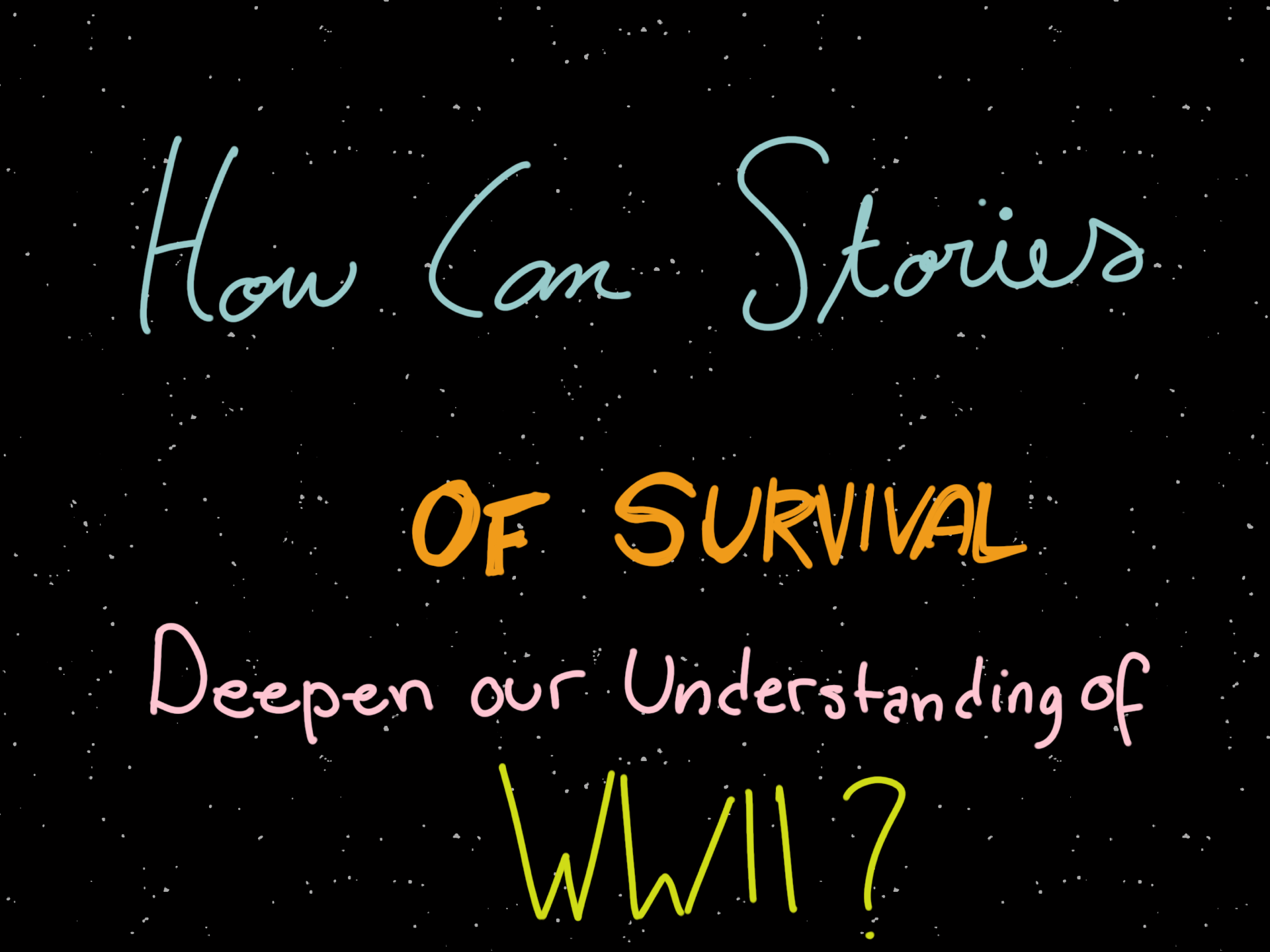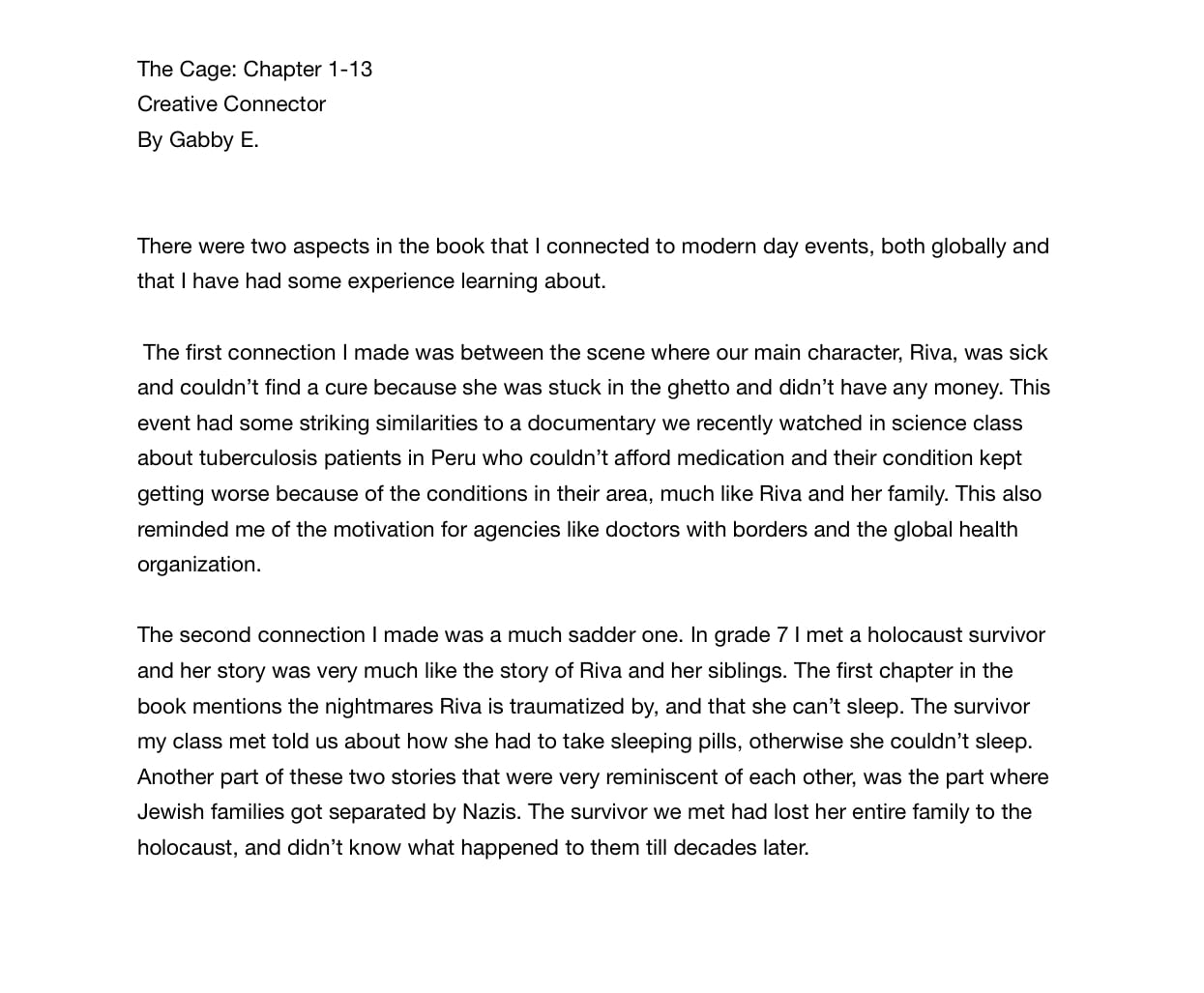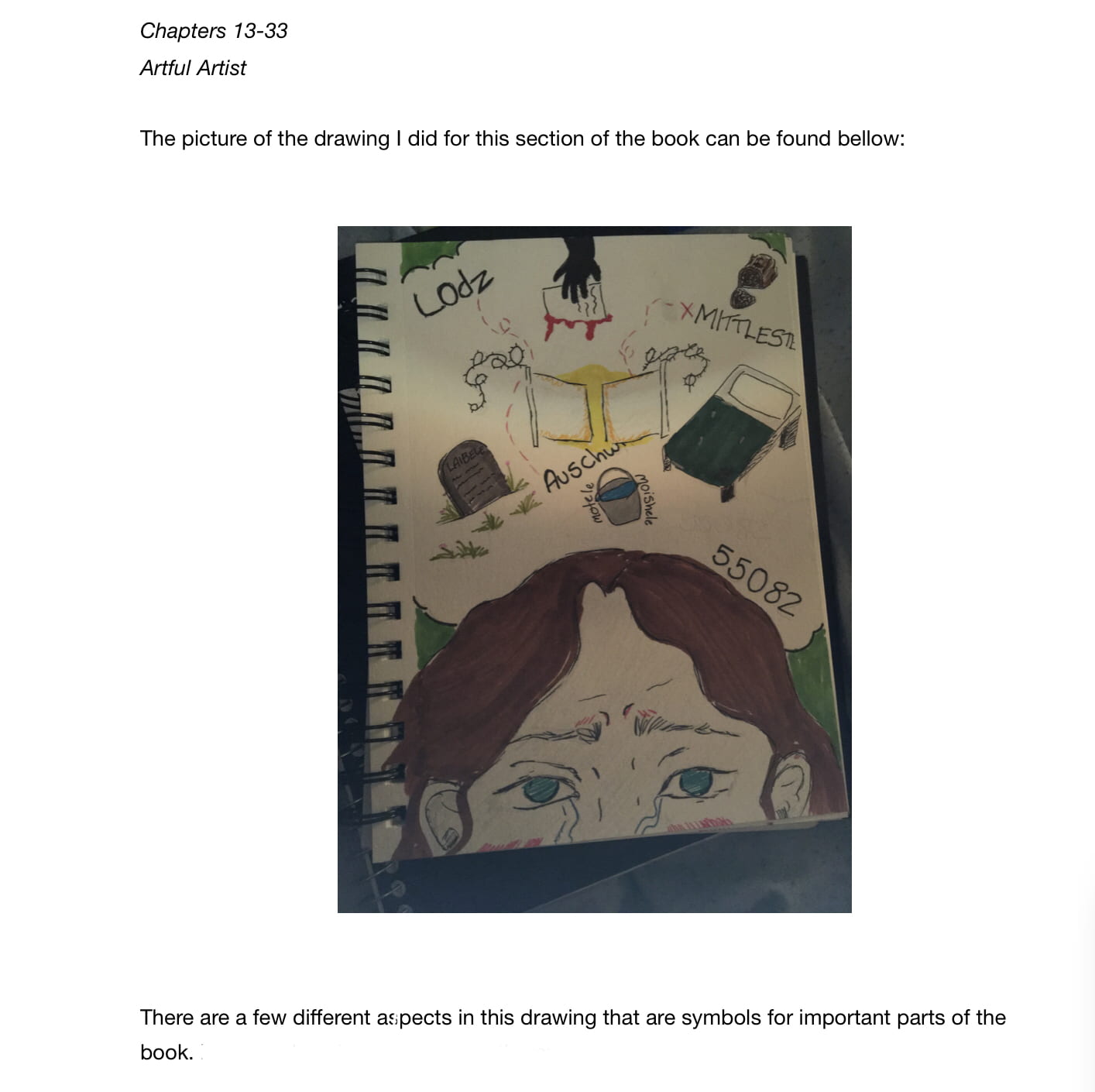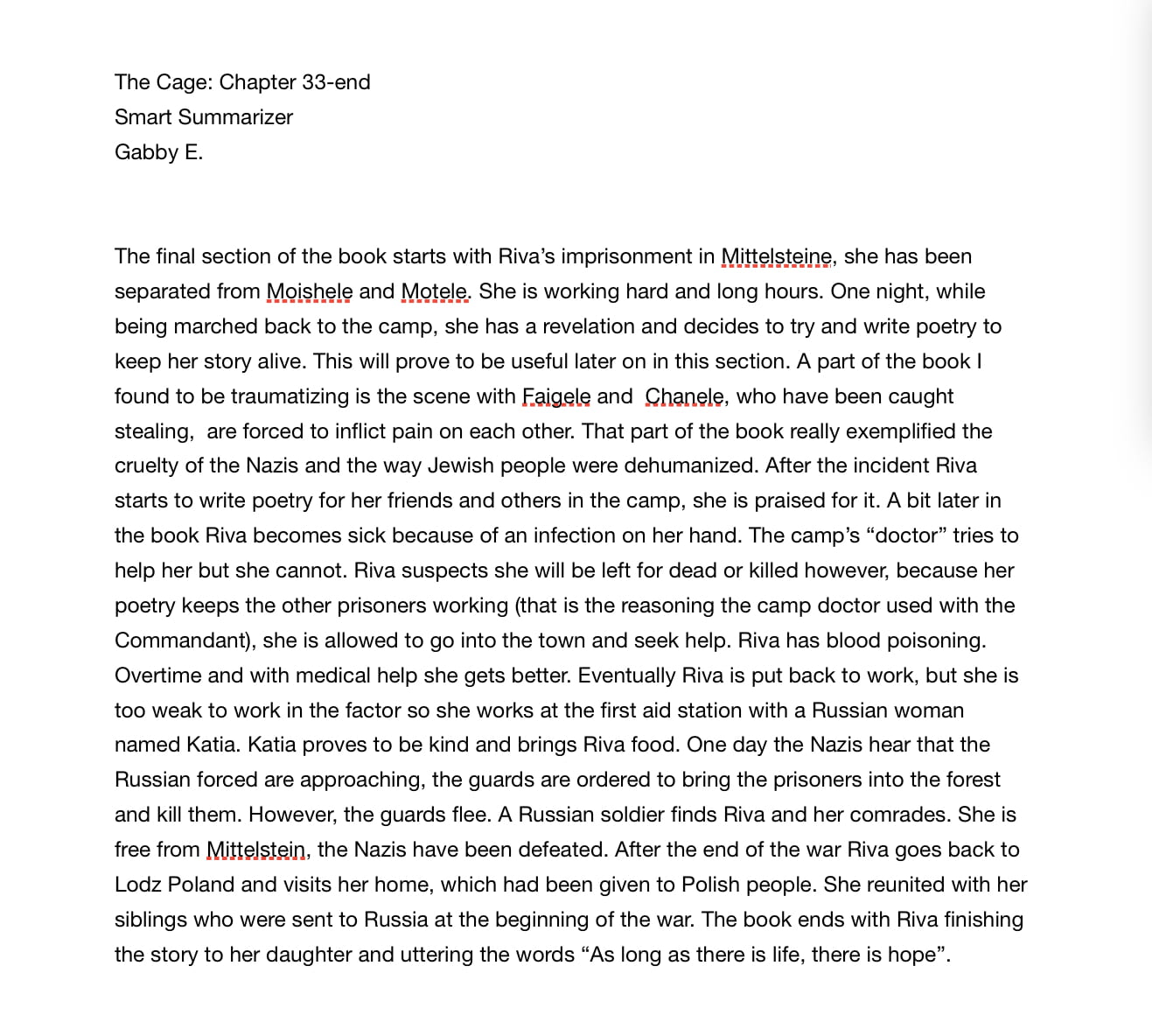Hello, welcome to today’s blog post. Before we continue I would like to say that this post does contain some historical events that some may find traumatizing.
In our latest humanities unit we covered a HUGE topic, this topic, as you might’ve guessed it was World War II.
To further our understanding of not only the logistical side of WWII, but the emotional and social side of WWII we studied a few very interesting books. The different books we could choose to read were:
1. The Cage by Ruth Minsky
2. Maus by Art Spiegelman
3. Salt to the Sea by Ruta Sepetys
These books were going to be helpful to answer our driving question which was:
Of course, that wasn’t all we did. After having been put into groups and assigned a book, we made a trailer for said books. The book I chose to read was The Cage by Ruth Minsky. You can see my groups completed trailer below:
Did you enjoy the video? Big shout out to my group members Lucy, Lennart, Amelia R. and very importantly Amelia B. (Millie), who did an amazing job with the editing. Now, here’s how we actually went about creating this trailer.
Step 1: Wait.. what actually happened in WWII?
Many of us, if not all of us, are familiar with WWII. What I mean by this is that everyone knows it happened but not everyone knows about the time line of WWII or really the significance of certain countries and battles. To understand more about certain obscure parts of WWII we did a couple of mini assignments.
We watched and took notes on a documentary that I found very insightful. You can watch it below:
To gain a broad understanding of key players and events in WWII we took some notes and made a “list” of sorts. You can see this below as well:
The last assignment I will mention was a “mini-podcast” assignment. We had watched a video about Canada’s involvement in WWII, and we had to make a podcast about a part of that video. I made mine about Canada’s contributions to the war, click here if you would like to listen.
Step 2: Historical Fiction Friday’s
You maybe have remembered that I mentioned that we were reading books and eventually making trailers out of them. To really understand our books we would have discussions every Friday. The book was divided into 3 parts, each week a different team member would have a different role in the discussions.
Here are the possible roles we could choose from:
Below you can see the roles I played and the reflective pieces I did in regards to the book.
Role #1: Creative Connector
Role #2: Artful Artist
Role #3: Smart Summarizer
Step 3: Screenplays and Storyboards
Any PLP students in or above grade 9 and any Humanities 10 students will by now be very familiar with screenplays and storyboards. They are, after all, integral to making a movie.
At this point in the project we had finished our books and we were now toying with the concept of how we were actually going to make these books into a trailer. The first step in doing this was establishing the important points of our story. The photo you see below is a jumble of all the ideas my group had, it really isn’t that clear but it will make sense (ish) as we go.
The second step was to write a screenplay. Contrary to most of the videos we have made in the past, most of our trailers contained very little dialogue and limited narration. What my group decided to do was to primarily take lines from the book, some of which we changed for context and others that we kept the same. The screenplay can be found below:
The third step was to make storyboards, so we could figure out what we would like our scenes to look like, what the angles might be like, how far away we would appear to be in the shot, how close, etc. The storyboard can be found below:
The final step before we could start filming was to create a call sheet. A call sheet is used to determine who is free for filming, when they are free, what they can do and what they can bring (i.e. props, costumes, sound equipment, camera etc.)
Step 4: Filming and Editing
Given the limited time frame we had to film, everything had to be done very quickly. We used a few different locations to film but most of them were around the school area.
To actually get things done efficiently, we all had to assume different roles. None of the roles were ever official but here’s how I see them:
Roles:
Lucy: Director, Writer, Actress, Storyboard and Organizer in Chief.
Amelia R.: Cameraman #1, Costuming, Actress and Film Consultant.
Gabby: Cameraman #2, Secondary Editor, Writing Assistant, Actress and Emotional Support to the Director.
Lennart: Actor, Writing Assistant, Storyboard, Props, Moral Support to Cameraman #1-3 and Conflict Mediator.
Millie: Cameraman #3, Editor in Chief, Costuming, Actress, Movie Connoisseur and Music Composer.
After we filmed it was time to assemble the video. Millie and myself were in charge of that. A fun part of the editing process was when we played around with filters and vignettes to get the desired “vintage” effect.
A very interesting learning experience that I got to take part in was getting to use software and a keyboard to create the music for our trailer. Shoutout to Millie’s dad for showing us how to use the right tools.
Here is our first draft of the video:
Our second draft of the video:
And our final draft:
Step 5: In conclusion
Overall this project was a very interesting way to study WWII, we looked at from both a historical and “logistical” point of view i.e. what happened, who was linked with who, where battles and campaigns occurred, etc. And from the a more “real” point of view, we did this by studying stories of those who had survived, who had overcome the danger and the death to tell their story. By studying the books and learning about the people that were involved in WWII we were able to answer our driving question
Having read the books really helped me understand the emotions and the feeling of the people during World War II. Making a trailer for this video led me to do further research on the book and practice my filming skills. If I could go back and change anything I might try and get a few more extra shots in there but that’s about it. Thank you for tuning (reading?) in today, see you next time!















